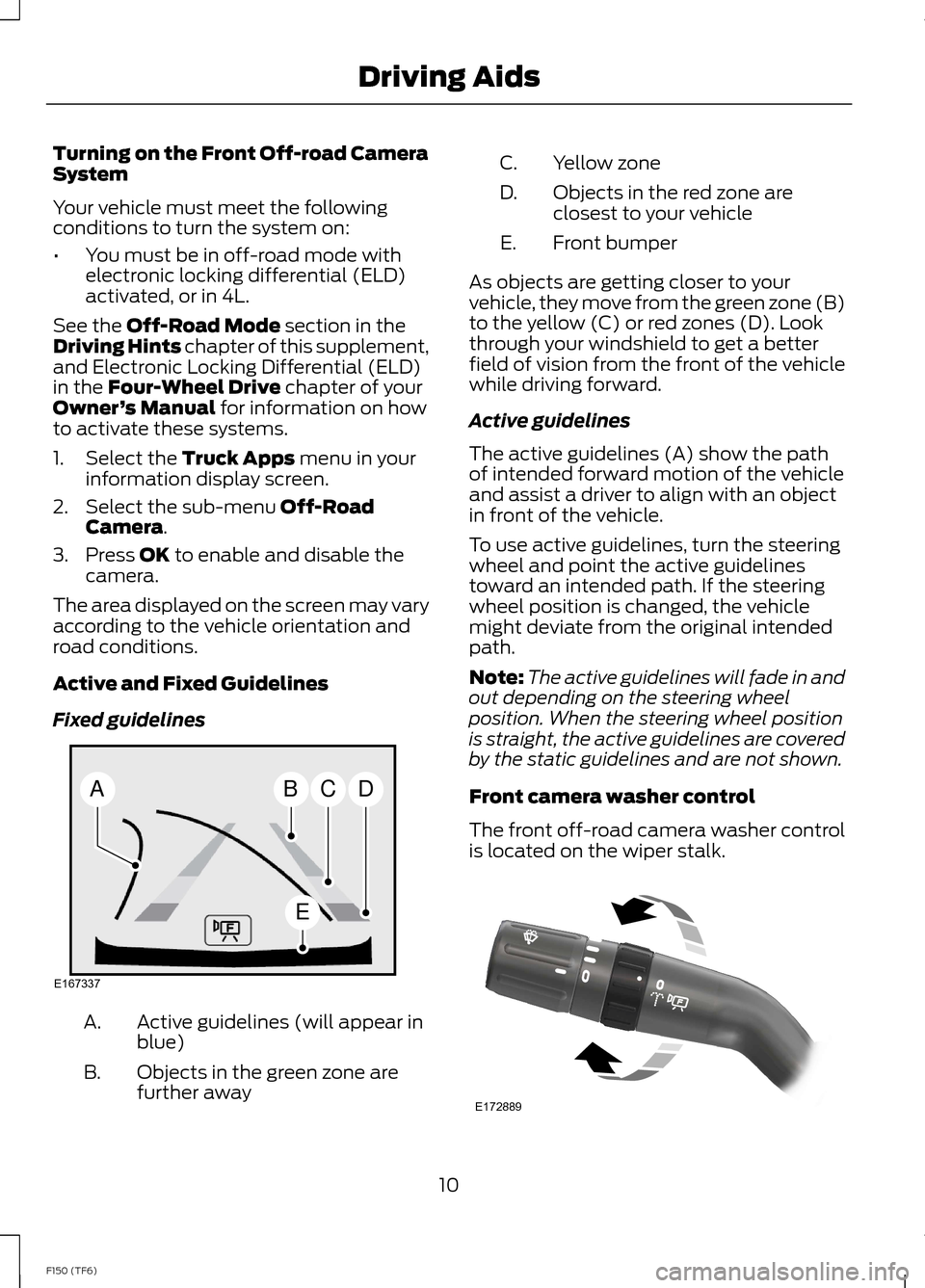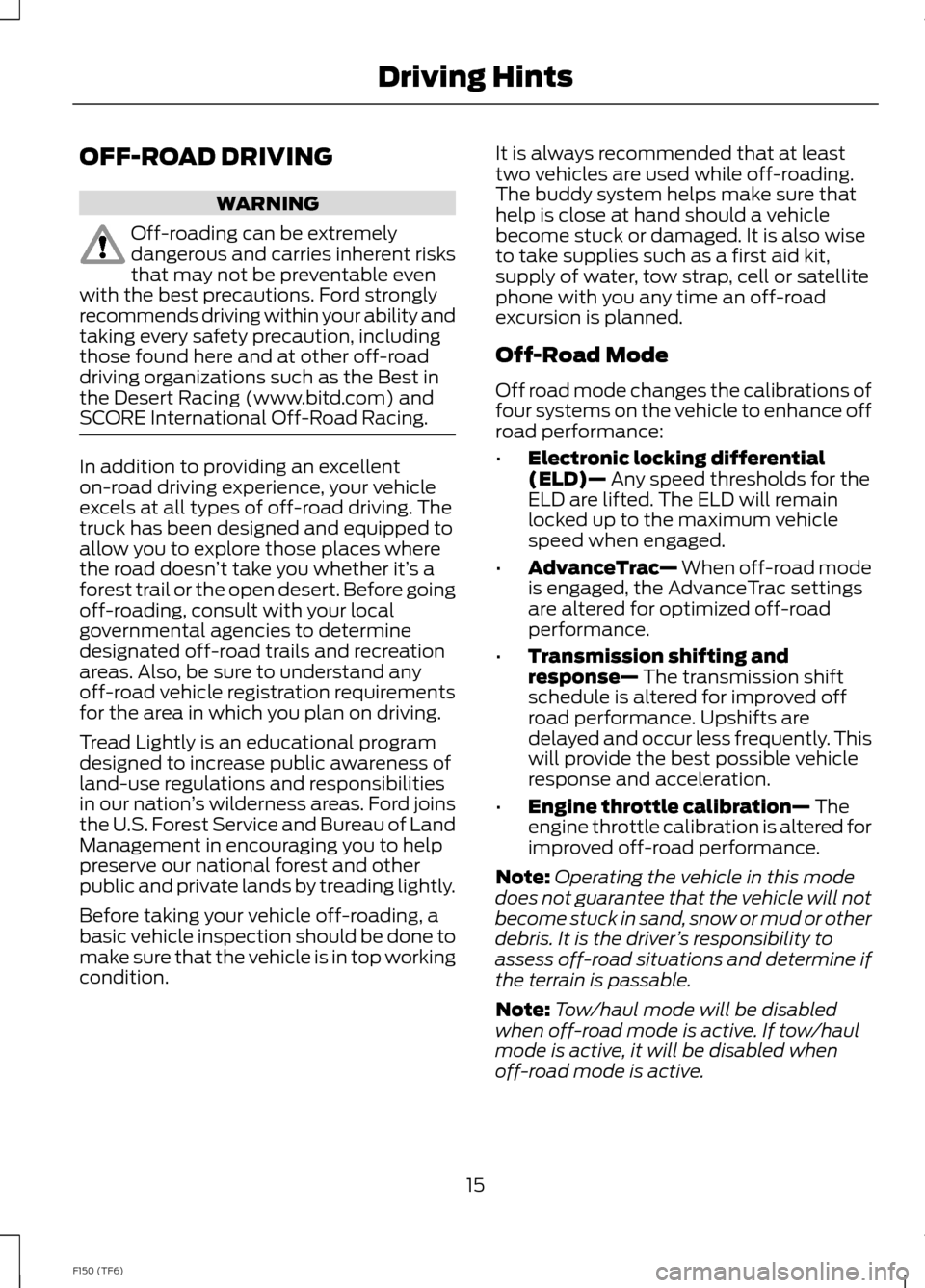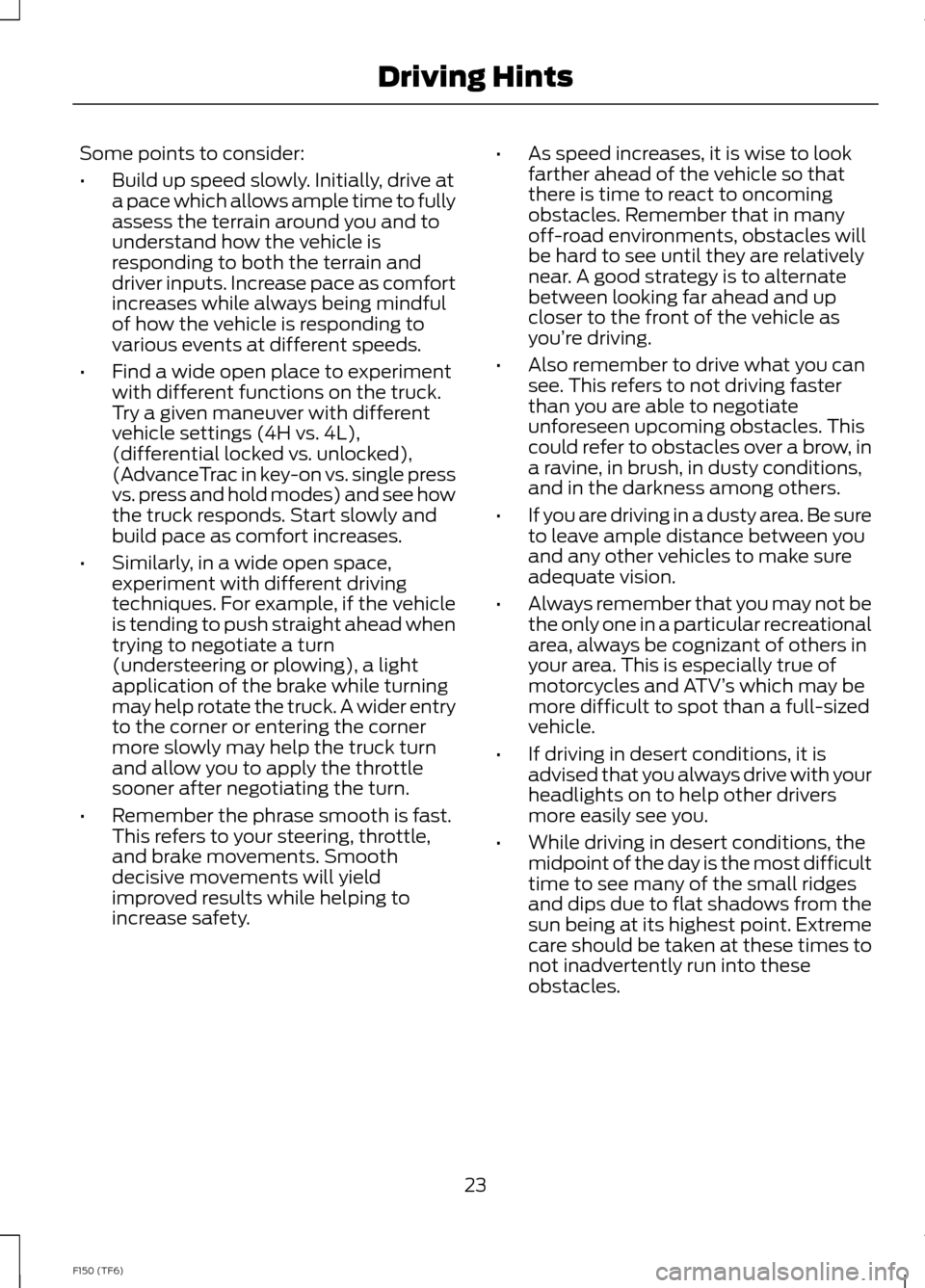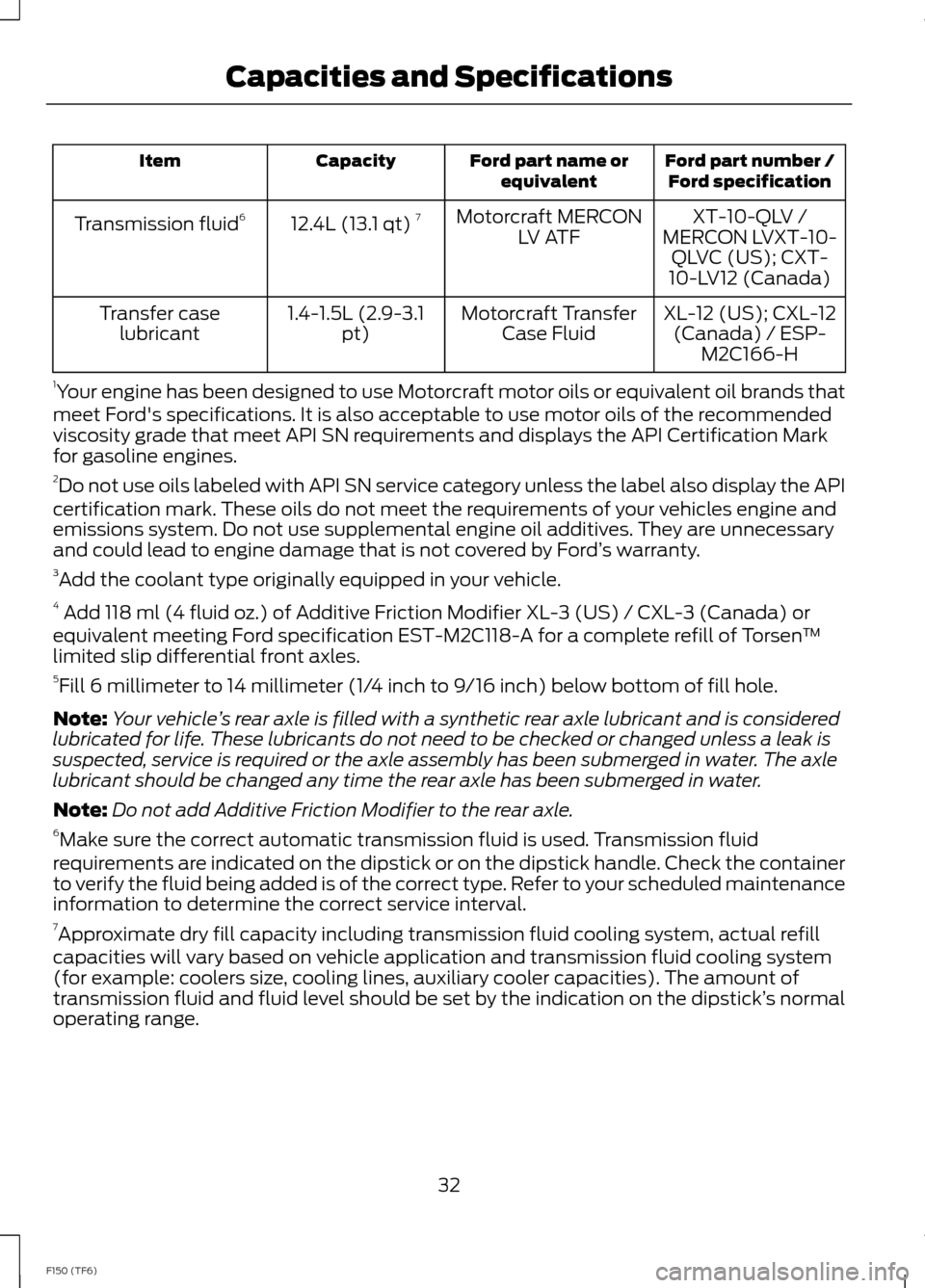2014 FORD F150 differential
[x] Cancel search: differentialPage 6 of 41

F-150 SVT Raptor-Specific ExteriorFeatures
•6.2L Boss V8 engine
•6R80 6-speed automatic transmission
•4x4 electronic shift-on-the-fly transfercase
•Modified rear differential capable oflocking in 2H, 4H and 4L
•Torsen helical front differential forincreased capability
•4.10 front and rear axle ratios
•35 tooth spline rear axle shafts forincreased capability
•Super Cab or Crew Cab – 5.5 foot boxwith unique outer box
•Box graphics
•Hood with functional air extractors
•Hood graphics
•Unique grille
•Front off-road camera
•Front camera washer
•Dual exhaust, 3.5 inch exhaust tips
•Modified rear bumper with integratedrear tow hooks
•Heavy duty front skid plate and engineskid plate, and front tow hooks
•Cast aluminum running board/sillprotector with Durabed protection
•Front fenders with functional airextractors
•Seats with increased bolstering andunique covers
•Front and rear LED marker lamps
•Switch pack with off-road mode andhill descent buttons, and four auxiliaryswitches
4F150 (TF6)At a GlanceE167331
Page 12 of 41

Turning on the Front Off-road CameraSystem
Your vehicle must meet the followingconditions to turn the system on:
•You must be in off-road mode withelectronic locking differential (ELD)activated, or in 4L.
See the Off-Road Mode section in theDriving Hints chapter of this supplement,and Electronic Locking Differential (ELD)in the Four-Wheel Drive chapter of yourOwner’s Manual for information on howto activate these systems.
1.Select the Truck Apps menu in yourinformation display screen.
2.Select the sub-menu Off-RoadCamera.
3.Press OK to enable and disable thecamera.
The area displayed on the screen may varyaccording to the vehicle orientation androad conditions.
Active and Fixed Guidelines
Fixed guidelines
Active guidelines (will appear inblue)A.
Objects in the green zone arefurther awayB.
Yellow zoneC.
Objects in the red zone areclosest to your vehicleD.
Front bumperE.
As objects are getting closer to yourvehicle, they move from the green zone (B)to the yellow (C) or red zones (D). Lookthrough your windshield to get a betterfield of vision from the front of the vehiclewhile driving forward.
Active guidelines
The active guidelines (A) show the pathof intended forward motion of the vehicleand assist a driver to align with an objectin front of the vehicle.
To use active guidelines, turn the steeringwheel and point the active guidelinestoward an intended path. If the steeringwheel position is changed, the vehiclemight deviate from the original intendedpath.
Note:The active guidelines will fade in andout depending on the steering wheelposition. When the steering wheel positionis straight, the active guidelines are coveredby the static guidelines and are not shown.
Front camera washer control
The front off-road camera washer controlis located on the wiper stalk.
10F150 (TF6)Driving AidsBECDAE167337 E172889
Page 17 of 41

OFF-ROAD DRIVING
WARNING
Off-roading can be extremelydangerous and carries inherent risksthat may not be preventable evenwith the best precautions. Ford stronglyrecommends driving within your ability andtaking every safety precaution, includingthose found here and at other off-roaddriving organizations such as the Best inthe Desert Racing (www.bitd.com) andSCORE International Off-Road Racing.
In addition to providing an excellenton-road driving experience, your vehicleexcels at all types of off-road driving. Thetruck has been designed and equipped toallow you to explore those places wherethe road doesn’t take you whether it’s aforest trail or the open desert. Before goingoff-roading, consult with your localgovernmental agencies to determinedesignated off-road trails and recreationareas. Also, be sure to understand anyoff-road vehicle registration requirementsfor the area in which you plan on driving.
Tread Lightly is an educational programdesigned to increase public awareness ofland-use regulations and responsibilitiesin our nation’s wilderness areas. Ford joinsthe U.S. Forest Service and Bureau of LandManagement in encouraging you to helppreserve our national forest and otherpublic and private lands by treading lightly.
Before taking your vehicle off-roading, abasic vehicle inspection should be done tomake sure that the vehicle is in top workingcondition.
It is always recommended that at leasttwo vehicles are used while off-roading.The buddy system helps make sure thathelp is close at hand should a vehiclebecome stuck or damaged. It is also wiseto take supplies such as a first aid kit,supply of water, tow strap, cell or satellitephone with you any time an off-roadexcursion is planned.
Off-Road Mode
Off road mode changes the calibrations offour systems on the vehicle to enhance offroad performance:
•Electronic locking differential(ELD)— Any speed thresholds for theELD are lifted. The ELD will remainlocked up to the maximum vehiclespeed when engaged.
•AdvanceTrac— When off-road modeis engaged, the AdvanceTrac settingsare altered for optimized off-roadperformance.
•Transmission shifting andresponse— The transmission shiftschedule is altered for improved offroad performance. Upshifts aredelayed and occur less frequently. Thiswill provide the best possible vehicleresponse and acceleration.
•Engine throttle calibration— Theengine throttle calibration is altered forimproved off-road performance.
Note:Operating the vehicle in this modedoes not guarantee that the vehicle will notbecome stuck in sand, snow or mud or otherdebris. It is the driver’s responsibility toassess off-road situations and determine ifthe terrain is passable.
Note:Tow/haul mode will be disabledwhen off-road mode is active. If tow/haulmode is active, it will be disabled whenoff-road mode is active.
15F150 (TF6)Driving Hints
Page 25 of 41

Some points to consider:
•Build up speed slowly. Initially, drive ata pace which allows ample time to fullyassess the terrain around you and tounderstand how the vehicle isresponding to both the terrain anddriver inputs. Increase pace as comfortincreases while always being mindfulof how the vehicle is responding tovarious events at different speeds.
•Find a wide open place to experimentwith different functions on the truck.Try a given maneuver with differentvehicle settings (4H vs. 4L),(differential locked vs. unlocked),(AdvanceTrac in key-on vs. single pressvs. press and hold modes) and see howthe truck responds. Start slowly andbuild pace as comfort increases.
•Similarly, in a wide open space,experiment with different drivingtechniques. For example, if the vehicleis tending to push straight ahead whentrying to negotiate a turn(understeering or plowing), a lightapplication of the brake while turningmay help rotate the truck. A wider entryto the corner or entering the cornermore slowly may help the truck turnand allow you to apply the throttlesooner after negotiating the turn.
•Remember the phrase smooth is fast.This refers to your steering, throttle,and brake movements. Smoothdecisive movements will yieldimproved results while helping toincrease safety.
•As speed increases, it is wise to lookfarther ahead of the vehicle so thatthere is time to react to oncomingobstacles. Remember that in manyoff-road environments, obstacles willbe hard to see until they are relativelynear. A good strategy is to alternatebetween looking far ahead and upcloser to the front of the vehicle asyou’re driving.
•Also remember to drive what you cansee. This refers to not driving fasterthan you are able to negotiateunforeseen upcoming obstacles. Thiscould refer to obstacles over a brow, ina ravine, in brush, in dusty conditions,and in the darkness among others.
•If you are driving in a dusty area. Be sureto leave ample distance between youand any other vehicles to make sureadequate vision.
•Always remember that you may not bethe only one in a particular recreationalarea, always be cognizant of others inyour area. This is especially true ofmotorcycles and ATV’s which may bemore difficult to spot than a full-sizedvehicle.
•If driving in desert conditions, it isadvised that you always drive with yourheadlights on to help other driversmore easily see you.
•While driving in desert conditions, themidpoint of the day is the most difficulttime to see many of the small ridgesand dips due to flat shadows from thesun being at its highest point. Extremecare should be taken at these times tonot inadvertently run into theseobstacles.
23F150 (TF6)Driving Hints
Page 34 of 41

Ford part number /Ford specificationFord part name orequivalentCapacityItem
XT-10-QLV /MERCON LVXT-10-QLVC (US); CXT-10-LV12 (Canada)
Motorcraft MERCONLV ATF12.4L (13.1 qt) 7Transmission fluid6
XL-12 (US); CXL-12(Canada) / ESP-M2C166-H
Motorcraft TransferCase Fluid1.4-1.5L (2.9-3.1pt)Transfer caselubricant
1Your engine has been designed to use Motorcraft motor oils or equivalent oil brands thatmeet Ford's specifications. It is also acceptable to use motor oils of the recommendedviscosity grade that meet API SN requirements and displays the API Certification Markfor gasoline engines.2Do not use oils labeled with API SN service category unless the label also display the APIcertification mark. These oils do not meet the requirements of your vehicles engine andemissions system. Do not use supplemental engine oil additives. They are unnecessaryand could lead to engine damage that is not covered by Ford’s warranty.3Add the coolant type originally equipped in your vehicle.4 Add 118 ml (4 fluid oz.) of Additive Friction Modifier XL-3 (US) / CXL-3 (Canada) orequivalent meeting Ford specification EST-M2C118-A for a complete refill of Torsen™limited slip differential front axles.5Fill 6 millimeter to 14 millimeter (1/4 inch to 9/16 inch) below bottom of fill hole.
Note:Your vehicle’s rear axle is filled with a synthetic rear axle lubricant and is consideredlubricated for life. These lubricants do not need to be checked or changed unless a leak issuspected, service is required or the axle assembly has been submerged in water. The axlelubricant should be changed any time the rear axle has been submerged in water.
Note:Do not add Additive Friction Modifier to the rear axle.6Make sure the correct automatic transmission fluid is used. Transmission fluidrequirements are indicated on the dipstick or on the dipstick handle. Check the containerto verify the fluid being added is of the correct type. Refer to your scheduled maintenanceinformation to determine the correct service interval.7Approximate dry fill capacity including transmission fluid cooling system, actual refillcapacities will vary based on vehicle application and transmission fluid cooling system(for example: coolers size, cooling lines, auxiliary cooler capacities). The amount oftransmission fluid and fluid level should be set by the indication on the dipstick’s normaloperating range.
32F150 (TF6)Capacities and Specifications